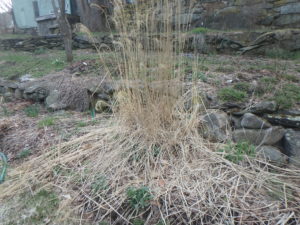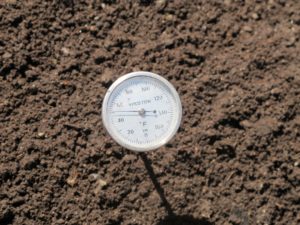Early Spring Chores
The snow is gone, and I am ready for gardening. And although I have been able to do a few things in the garden, the soil is wet and easily compacted, so I can’t do much until it dries out.
Many of my flower beds are six feet or more deep (from front to back). This means I can’t stand on the lawn and reach to the back to remove leaves or sticks. I don’t want to walk into the beds and risk compacting the soil. Plants get their oxygen through their roots, and compacted soil has little space for air. The solution? I place a plank on the soil and walk on that. It spreads out my weight.
I generally advise gardeners to wait until the lawn gets green before raking out the sand and dirt that was dumped by the snowplows. I say this because dormant grass is easily pulled up by vigorous raking. But this year I had a lot of sand, and I feared the mess would choke out large sections of lawn near the road. So I used a plastic rake, and raked gently, and I was able to clean up with very little damage to the lawn.
Other chores? If you have decorative grasses in your perennial border, it is important to cut back last year’s stems now, before new growth occurs. I don’t cut back decorative grasses in the fall: I like to see them standing up in the snow, waving in the winter wind.
I have a big clump of tall maiden grass, Miscanthus sinensis, a variety called ‘Morning Light’. Last year it had started growing before I got around to cutting it back, and there was no way to remove the bottom 8 inches of dead grass, which was unsightly. This year I cut it back low to the ground early and won’t have that problem. Hand pruners work best for cutting back the stems.
The moles and voles always make a mess of the lawn, digging up soil and leaving lumps and squiggles of soil they displaced in winter. I’ve been cleaning that up now, too. I have an aluminum grain scoop/shovel that is 14 inches across and very lightweight. I use a short-tined rock rake to dislodge the lumps and get them onto my shovel. I consider this soil a gift from the rodents. It is good soil that I use to fill holes and top-up raised beds that need some added topsoil.
Although I know people have already started their peas and spinach, my soil is awfully cold for them. Yes, you can plant the seeds when the soil is 50 degrees F, but waiting until it is 60 degrees makes sense to me. Seeds germinate much more quickly in warmer soil, so there is less chance of the seeds rotting.
A soil thermometer is not an expensive item and will last a lifetime. I have a few, and they all have dials like old-fashioned oven thermometers. The sensor is right on the tip. Keep that in mind when checking soil temperatures. If you push the tip down 6 inches, the soil will be cold at this time of year – but you are not planting seeds that deep. Instead measure the soil temperature an inch down, which means holding the thermometer upright for a couple of minutes while it adjusts. Otherwise it will fall over – hence the impulse to push it down deep.
Near the end of April I moved my cold frame out of the barn and into the garden. This is a cedar box with polycarbonate lids that allow sunshine into the box, and hold heat in. The polycarbonate helps diffuse the light, reducing chances of cooking the plants. The lids are on a slant, and open on hinges.
After a couple of sunny days the soil inside the box had warmed up, and I planted seeds of lettuce, kale and carrots inside. Once they sprout, I’ll lift the lids a little each sunny day to allow air circulation and to moderate temperatures. The box itself is 8 feet long and 2 feet across. I got mine from Gardeners Supply (www.gardeners.com or 888-833-1412).
Meanwhile, indoors, I have 5 flats of seedlings growing under lights. These require daily attention, though not much. I water, and I pluck out or snip off extra seedlings that grow. I want just one tomato plant per cell, for example, though I always plant 2 per cell just to be sure that I get one to grow. It’s hard to kill a cute little tomato plant, but I know that the survivor will do better if it’s not competing for water and nutrients.
Other early plants I have started include lettuce, kale, purple cauliflower, 3 kinds of flowers and Happy Rich. Happy Rich is a non-heading broccoli I get from Johnny’s Seeds. It produces the equivalent of side shoots on regular broccoli, but it is quicker to produce, and keeps on cranking out its green blossoms well into the fall. The part we eat is really the buds of its flowers. I have never seen Happy Rich seedlings for sale in a nursery, so I start my own each year.
Another recent chore involved taking the straw mulch off my strawberry plants. Once the plants and the new plants started by runners are awake and growing, I’ll cut any runners connected to the mother plant.
There will still be frosty nights here, and raw rainy days. But I know the worst is over, and summer is just around the corner.
Read Henry’s blog posts at https://dailyuv.com/
Early Spring Chores
Spring finally seems to be coming to Cornish Flat – about a month late, this year. My snowdrops are just starting to bloom and large patches of snow are still on the lawn and garden – though there are bare spots. I really want to get outside and start cleaning up the yard and garden beds, but will try to hold myself back until things have dried out.
Why is it important to wait before doing much gardening? It’s all about soil structure. Soil is made up of ground rock, organic matter and air spaces. The mineral component is about 45%, organic matter can be from 1% to 10% or more, and the rest consists of air spaces. That last component is as important as the first two.
Plant roots that we can see when we dig up a weed or plant a shrub are only a part of the entire root. The parts of the root that absorbs water, oxygen and minerals are so fine that we cannot see them. They are called root hairs, but they are even finer than human hair, microscopically fine. And there are lots of them. Most plants have branch roots that spread out and branch again and again. Root hairs are short protuberances attached to those branching roots. But fine roots cannot push through packed soil as easily as through fluffy soil. The total length of root tissues in a single rye plant is around 380 miles.
As you know, if you walk on soggy lawn you leave foot prints. That means that you have squeezed air out of the soil and compacted it – making it all the harder for roots and root hairs to extend and thrive. Not only that, green plants get their oxygen from the soil via their roots. If the oxygen is squeezed out, plants can’t get it.
So what can a gardener do? Wait. Don’t walk on your lawn if you see footprints or hear a squish. Don’t rake winter debris from the lawn while the lawn is still dormant. If you do, you risk pulling up the grass, roots and all. And stay out of flower beds even later into the spring – they are more susceptible to compaction than your lawn.
So what can you do in early April? Clean and sharpen your tools, including the handles. I have a potato hoe, a 5-tined rake-like tool that has been in my family for over 50 years. It has its original wood handle, which is still in perfect condition – even though I use it for weeding and soil prep every week, often every day, all summer. How is that possible? I try to oil the handle every year either in the fall or the early spring. And I don’t leave the tool outside in the sun or rain. No matter how tired I am at the end of the day I walk the potato hoe back to the barn before I go to the house.
To clean up a wooden handle, first I use fine steel wool (or a green scrubbie) to polish up the handle and remove any rough spots. Then I apply a coat of boiled linseed oil with a brush or rag. I let it soak in for a few hours, then rub off any excess. Or if the oil soaks right in, I might even apply a second coat. The steel tines I clean with steel wool and apply a light coat of sewing machine oil.
This year I need to oil the wood on my wooden wheel barrow and tighten up all the bolts. One of my first memories in my life is of my Grampy picking me up, plunking me down in his wooden wheelbarrow on a pile of weeds, and racing us back to the barn ahead of a fast-approaching thunderstorm. I might have been just two years old. The ride was bumpy – there was a steel-rimmed wooden wheel – but it was exciting!
Unfortunately that wooden wheelbarrow disappeared after Grampy went off to the great garden in the sky. But many years later I tracked down an Amish woodworker in Pennsylvania, Ike Lapp, who still makes wooden wheelbarrows and got myself one. It’s pretty much the same wheelbarrow I remember my grandfather using. When I finished assembling it I pushed it across the lawn for a test drive and it made the same squeak that my grandfather’s wheelbarrow did.
I called Ike Lapp at his home in Gordonville, PA recently. He is old order Amish, so does not have a phone in his house or workshop. Instead he has a phone and answering machine in a separate 4-foot square building in a field. (He checks messages once a day and calls customers back. He’s at 717-355-9366 717-355-9366). He told me he is still making the wheelbarrows and in addition to mine, a large premium grade wheelbarrow for around $300, he has smaller ones, and some in “rustic grade”. He does not have a web site, but you can see his wheelbarrows at www.lehmans.com.
717-355-9366). He told me he is still making the wheelbarrows and in addition to mine, a large premium grade wheelbarrow for around $300, he has smaller ones, and some in “rustic grade”. He does not have a web site, but you can see his wheelbarrows at www.lehmans.com.
Later, when your ground has dried out and you are raking and weeding flower beds, try to reach in with your rake, keeping your feet out of the beds. If you must walk in flower beds, bring along a couple of short planks. Place them in the flower bed and step on the boards to distribute your weight. Or if you are not worried about what the neighbors will say, you could wear your snowshoes. After the winter we’ve had, that seems appropriate!
Henry Homeyer is a gardening consultant and the author of 4 gardening books. His web site is www.Gardening-Guy.com.






